Remote Sensing and Digital Image Processing with R - Lab Manual 1032461241, 9781032461243
This Lab Manual is a companion to the textbook Remote Sensing and Digital Image Processing with R. It covers examples of
655 67 30MB
English Pages 188 [189] Year 2023
Cover
Half Title
Title Page
Copyright Page
Contents
About the Authors
Preface
1. Principles of R Language in Remote Sensing and Digital Image Processing
2. Introduction to Remote Sensing and Digital Image Processing with R
3. Remote Sensing of Electromagnetic Radiation
4. Remote Sensing Sensors and Satellite Systems
5. Remote Sensing of Vegetation
6. Remote Sensing of Water
7. Remote Sensing of Soils, Rocks, and Geomorphology
8. Remote Sensing of the Atmosphere
9. Scientific Applications of Remote Sensing and Digital Image Processing for Project Design
10. Visual Interpretation and Enhancement of Remote Sensing Images
11. Unsupervised Classification of Remote Sensing Images
12. Supervised Classification of Remote Sensing Images
13. Uncertainty and Accuracy Analysis in Remote Sensing and Digital Image Processing
14. Scientific Applications of Remote Sensing and Digital Image Processing to Enhance Articles
References
Index
Recommend Papers
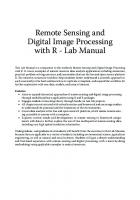
- Author / Uploaded
- Marcelo de Carvalho Alves
- Luciana Sanches
- Similar Topics
- Computers
- Algorithms and Data Structures: Image Processing
File loading please wait...
Citation preview
Remote Sensing and Digital Image Processing with R - Lab Manual This Lab Manual is a companion to the textbook Remote Sensing and Digital Image Processing with R. It covers examples of natural resource data analysis applications including numerous, practical problem-solving exercises, and case studies that use the free and open-source platform R. The intuitive, structural workflow helps students better understand a scientific approach to each case study in the book and learn how to replicate, transplant, and expand the workflow for further exploration with new data, models, and areas of interest. Features •• Aims to expand theoretical approaches of remote sensing and digital image processing through multidisciplinary applications using R and R packages. •• Engages students in learning theory through hands-on real-life projects. •• All chapters are structured with solved exercises and homework and encourage readers to understand the potential and the limitations of the environments. •• Covers data analysis in the free and open-source R platform, which makes remote sensing accessible to anyone with a computer. •• Explores current trends and developments in remote sensing in homework assignments with data to further explore the use of free multispectral remote sensing data, including very high spatial resolution information. Undergraduate- and graduate-level students will benefit from the exercises in this Lab Manual, because they are applicable to a variety of subjects including environmental science, agriculture engineering, as well as natural and social sciences. Students will gain a deeper understanding and first-hand experience with remote sensing and digital processing, with a learn-by-doing methodology using applicable examples in natural resources.
Remote Sensing and Digital Image Processing with R - Lab Manual
Marcelo de Carvalho Alves Luciana Sanches
Designed cover image: © Shutterstock First edition published 2023 by CRC Press 6000 Broken Sound Parkway NW, Suite 300, Boca Raton, FL 33487-2742 and by CRC Press 4 Park Square, Milton Park, Abingdon, Oxon, OX14 4RN CRC Press is an imprint of Taylor & Francis Group, LLC © 2023 Taylor & Francis Group, LLC Reasonable efforts have been made to publish reliable data and information, but the author and publisher cannot assume responsibility for the validity of all materials or the consequences of their use. The authors and publishers have attempted to trace the copyright holders of all material reproduced in this publication and apologize to copyright holders if permission to publish in this form has not been obtained. If any copyright material has not been acknowledged please write and let us know so we may rectify in any future reprint. Except as permitted under U.S. Copyright Law, no part of this book may be reprinted, reproduced, transmitted, or utilized in any form by any electronic, mechanical, or other means, now known or hereafter invented, including photocopying, microfilming, and recording, or in any information storage or retrieval system, without written permission from the publishers. For permission to photocopy or use material electronically from this work, access www.copyright.com or contact the Copyright Clearance Center, Inc. (CCC), 222 Rosewood Drive, Danvers, MA 01923, 978-750-8400. For works that are not available on CCC please contact [email protected] Trademark notice: Product or corporate names may be trademarks or registered trademarks and are used only for identification and explanation without intent to infringe. ISBN: 978-1-032-46124-3 (pbk) ISBN: 978-1-003-38041-2 (ebk) DOI: 10.1201/9781003380412 Typeset in Latin Modern font by KnowledgeWorks Global Ltd. Publisher’s note: This book has been prepared from camera-ready copy provided by the authors.
Contents
About the Authors Preface 1 Principles of R Language in Remote Sensing and Digital Image Processing
vii ix 1
2 Introduction to Remote Sensing and Digital Image Processing with R
21
3 Remote Sensing of Electromagnetic Radiation
33
4 Remote Sensing Sensors and Satellite Systems
47
5 Remote Sensing of Vegetation
53
6 Remote Sensing of Water
59
7 Remote Sensing of Soils, Rocks, and Geomorphology
67
8 Remote Sensing of the Atmosphere
77
9 Scientific Applications of Remote Sensing and Digital Image Processing for Project Design
83
10 Visual Interpretation and Enhancement of Remote Sensing Images
85
11 Unsupervised Classification of Remote Sensing Images
101
12 Supervised Classification of Remote Sensing Images
115
13 Uncertainty and Accuracy Analysis in Remote Sensing and Digital Image Processing
141
14 Scientific Applications of Remote Sensing and Digital Image Processing to Enhance Articles
153
References
169
Index
177
v
About the Authors
Marcelo de Carvalho Alves Dr. Alves is an associate professor at the Federal University de Lavras, Brazil. His education includes master’s, doctoral, and post-doctoral degrees in Agricultural Engineering at Federal University of Lavras, Brazil. He has varied research interests and has published on surveying, remote sensing, geocomputation, and agriculture applications. He has over 20 years of extensive experience in data science, digital image processing, and modeling using multiscale, multidisciplinary, multispectral, and multitemporal concepts applied to different environments. Experimental field sites included a tropical forest, savanna, wetland, and agricultural fields in Brazil. His research has been predominantly funded by CNPq, CAPES, FAPEMIG, and FAPEMAT. Over the years, he has built a large portfolio of research grants, mostly relating to applied and theoretical remote sensing, broadly in the context of vegetation cover, plant diseases, and related impacts of climate change. Luciana Sanches Dr. Sanches graduated with a degree in Sanitary Engineering from the Federal University of Mato Grosso, Brazil, a master’s degree in Sanitation, Environment, and Water Resources from the Federal University of Minas Gerais, a PhD in Road Engineering, Hydraulic Channels, and Ports from Universidad de Cantabria, Spain, a post-doctorate degree in Environmental Physics, Brazil, and a post-doctorate degree in Environmental Sciences from the University of Reading, United Kingdom. Her education includes postgraduate degrees in Workplace Safety Engineering at Federal University of Mato Grosso, Brazil, and in Project Development and Management for Municipal Water Resources Management at the National Water Agency, Brazil. She is currently an associate professor at the Federal University of Mato Grosso, and worked for more than 20 years in research on atmosphere-biosphere interaction, hydrometeorology in various temporal-spatial scales with interpretation based in environmental modeling and remote sensing. She has been applying remote sensing in teaching and research activities to support the interpretation of environmental dynamics.
vii
Preface
Remote sensing and digital image processing enable us to understand functioning mechanisms and geospatial relationships between ecological variables of agroecosystems and ecosystems, over large areas, repeatedly. This lab manual is a companion to the first edition of the textbook Remote Sensing and Digital Image Processing with R. Examples of natural resource data analysis applications are covered including numerous practical, problem-solving exercises, and case studies that use the free and open-source platform R. The book methodology aims to expand theoretical approaches of remote sensing and digital image processing from multidisciplinary applications using R and R packages to engage students in learning theory through hands-on real-life projects. The intuitive, structural workflow helps students better understand a scientific approach to each case study in the book, in order to easily replicate and expand the workflow for further exploration with new data, models, and regions of interest. All chapters are structured with solved exercises and homework and can be used widely in environmental science and agriculture engineering as well as in the physical, natural, and social sciences, at the undergraduate and graduate levels. The items covered in the chapters are defined in a form of constructive complexity that allows the student to develop a project using remote sensing and geospatial data, and finally, conclude the studies with a report in the form of a scientific article or scientific review of remote sensing applied to agricultural and environmental analysis. The chapters covered are “Principles of R Language in Remote Sensing and Digital Image Processing” (Chapter 1), “Introduction to Remote Sensing and Digital Image Processing with R” (Chapter 2), “Remote Sensing of Electromagnetic Radiation” (Chapter 3), “Remote Sensing Sensors and Satellite Systems” (Chapter 4), “Remote Sensing of Vegetation” (Chapter 5), “Remote Sensing of Water” (Chapter 6), “Remote Sensing of Soils, Rocks, and Geomorphology” (Chapter 7), “Remote Sensing of the Atmosphere” (Chapter 8), “Scientific Applications of Remote Sensing and Digital Image Processing for Project Design” (Chapter 9), “Visual Interpretation and Enhancement of Remote Sensing Images” (Chapter 10), “Unsupervised Classification of Remote Sensing Images” (Chapter 11), “Supervised Classification of Remote Sensing Images” (Chapter 12), “Uncertainty and Accuracy Analysis in Remote Sensing and Digital Image Processing” (Chapter 13), “Scientific Applications of Remote Sensing and Digital Image Processing to Enhance Articles” (Chapter 14). Marcelo de Carvalho Alves and Luciana Sanches, Lavras, June 2023
ix
1 Principles of R Language in Remote Sensing and Digital Image Processing
1.1
Introduction
R is a free software environment for statistical computing and graphics which compiles and runs on a wide variety of UNIX platforms, Windows and MacOS. R is a powerful environment for digital image processing, geocomputation, as well as for obtaining and analyzing remote sensing data (Lovelace et al., 2019). However, R has been used in different areas of knowledge, and applied in teaching different disciplines such as computational statistics (Taylor, 2018), biostatistics (Sarvary, 2014), data mining (Hussain, 2015), data science (Matter, 2021), data analytics (Patil, 2016). R can run on many operating systems, but this book is prepared with R used on a Windows 10 version. Other versions such as Mac and Linux can also be used for R (Douglas et al., 2022; Rodríguez, 2022). The objective of this chapter is to provide a foundation for readers to quickly move forward with using R in subsequent chapters where there are more advanced applications of processing, analyzing, and geovisualizing geospatial data and remote sensing imagery. To understand and apply digital image processing techniques to remote sensing data, it is essential to know basic objects that store various types of data in R, as well as functions and graphics used to generate scientific knowledge and useful information for thematic mapping.
1.2
The R Language and Environment
The R language was first created and released in a paper published by Ihaka & Gentleman (1996), and is now under active development by a group of statisticians called “the R core team1 ”. The R language was inspired by the S language developed by John Chambers and others at Bell Labs. However, the modern implementation of R is far more popular than S. R is freely available and distributed under the terms of the Free Software Foundation’s GNU General Public License. R software can be obtained from the Comprehensive R Archive Network (CRAN) where R and R packages ready to run on Windows, Mac OS, and Linux are available. The source code is also available for download and can be compiled for other platforms (Rodríguez, 2022). The popularity of R compared to other computer languages has been prominent among the most used languages in the contemporary world and can be evaluated in relation to its use as a working tool and its use in data science and data analysis software. The creation of new packages has occurred exponentially (Douglas et al., 2022; Hornik, 2012a; Muenchen, 2022). 1 https://www.r-project.org
1
2
1 Principles of R Language in Remote Sensing and Digital Image Processing
The popularity of R can be attributed to factors such as (Douglas et al., 2022): • • • •
R is open source and freely available; R is available for Windows, Mac, and Linux operating systems; R has an extensive and coherent set of tools for statistical analysis; With R it is possible to widely explore graphical aspects with flexibility and the ability to produce publishing-quality science; • In R there is a growing set of packages freely available to extend R’s capabilities; • R has an extensive online support network and freely available documents. Furthermore, with the use of R, robust and reproducible research practices can be realized when compared to graphical user interface (GUI) software. Thus, it is possible to write code instead of clicking on links and perform analysis with a permanent and accurate record of all methods used and decisions made during data analysis. The code can be shared along with data so that other scientists, technicians and users can exactly reproduce the analysis. This fulfills one of the principles of open science and reproducible reporting with version control (Douglas et al., 2022).
1.3
Why Learn to Program?
With lower computing costs, lower digital data storage costs, and the spread of the Internet, there has been a marked increase in the availability of digital data describing everyday human activities (Einav & Levin, 2014; Matter, 2021). New business models and economic structures are emerging with use of data as the main commodity, determining technological and economic change related to artificial intelligence. This type of economy relies heavily on the processing, analysis, management of large amounts of digital data, as in the case of remote sensing and digital image processing of the Earth’s environment. The need for proper handling of large amounts of digital data has given rise to the interdisciplinary field of data science, as well as to a growing demand for data scientists. This type of science approach is related to the scientific process of remote sensing, where responses to challenges are needed for monitoring and problem solving using a combination of skills and knowledge from different areas of knowledge, including geomatics, geocomputation, geostatistics and statistics. Remote sensing and digital image processing with R can be used in conjunction with recent developments in data science and career opportunities related to machine learning and programming, bringing benefits and scientific and technical quality to undergraduate, graduate, and service work in areas related to geographic problem solving, agricultural and environmental management, and forensics. R is a high-level computer language, relatively easy to learn for people with no previous programming experience. The syntax is quite intuitive, with few complex error messages. Thus, learning by doing a routine previously prepared by the teacher can facilitate learning. Also, with the recent sharp increase in popularity of R, there are many freely accessible online resources that help beginners learn and use the language (Matter, 2021).
1.4 History of R
1.4
3
History of R
R is an open source implementation of the S programming language that allows you to define objects in predetermined blocks instead of the entire code. S was introduced by Becker & Chambers (1984). Since then, new versions of the S language have been created. In 1994, Ross Ihaka & Gentleman (1996) wrote a version of S at the University of Auckland and named it R (Patil, 2016). In 1995, R software was made free and open source under the GNU General Public License. The first official version was released in June 1995. In 1997 R became an official part of the GNU collaborative free software project, with code hosted and maintained by the Concurrent Versions System (CVS). The Comprehensive R Archive Network (CRAN) was officially founded in 1997 (Hornik, 2012b). The R Core Team was formed in 1997 to further develop the R language. In 1999 the first versions of functions for downloading, installing and updating packages appeared. The first official stable version of R for production and use was released on February 29, 2000 (Dalgaard, 2008; Ihaka, 1998). In April 2003, the R Foundation was designated as a non-profit organization to provide further support for the R project (Fox, 2009). Since January 2022, it consists of the R Core team, including collaborative results from scientists around the world (R Core Team, 2020). In CRAN are stored R executable files, source code, documentation, and user-contributed packages. CRAN originally had 3 mirrors and 12 packages. Since January 2022, there are 101 mirrors and 18,728 contributed and hosted packages of programs (binaries) for major Linux, macOS, and Windows distributions (R Core Team, 2020; The R Foundation, 2022). Currently there is an extensive and rapidly growing R literature. In the area of remote sensing and digital image processing of remote sensing data, much of the existing literature and examples is the work of package developers and R users around the world, with emphasis on developmentrelated scientists, operation and updating of packages such as raster (Hijmans et al., 2020), terra (Hijmans et al., 2022), luna (Ghosh et al., 2021), stars (Pebesma et al., 2022), sf (Pebesma et al., 2021), RStoolbox (Leutner et al., 2019), rgee (Aybar et al., 2022), ggplot2 (Wickham et al., 2022), tmap (Tennekes et al., 2020), mapview (Appelhans et al., 2020), and others. The open source R programming language and statistical computing environment has in the last decade become a key tool for data science in industry and academia. Its initial conception was for statistical analysis, but nowadays the potential for remote sensing data analysis has been expanded with the update and emergence of new R packages to handle large volumes of data with efficient processing algorithms. Many features of the language have made R useful for working with data, and it has been extended with the growth of data economics and data science, with no limit on its use in various domains, going these days far beyond traditional academic research applications (Matter, 2021). Official R manuals are distributed as PDF files or online help service that can assist on introductory and advanced aspects from installation to data manipulation and dissemination of results.
1.5
R’s Growth
Advances in technology have paved the way for increasingly powerful, sophisticated, and comprehensive data analysis tools. Programming languages allow analysts to define or customize their
4
1 Principles of R Language in Remote Sensing and Digital Image Processing
own functions or apply functions developed by experts around the world. By working directly with programming languages, analysts can design and implement operations, models, and other tools that meet specific needs. Programming languages can be ranked in terms of demand and popularity of programmers. Before choosing a programming language, one should consider factors such as popularity, demand, career opportunities, and applications. In 2015, R was ranked sixth out of 10 languages cited. Furthermore, as the amount of data-intensive work increases, the demand for tools such as R for data mining, processing, and visualization also tends to increase (Patil, 2016). Currently, R has been cited among 10 programming languages as a recommendation for 2022 (Abbott, 2021).
1.5.1
R in business
R originated as an open-source version of the S programming language in the 1990s. It has since gained the support of several companies, most notably RStudio and Revolution Analytics, which are used to create packages and services related to the language. R is backed by large companies that power some of the largest relational databases in the world such as Oracle (Patil, 2016). Many large technology companies like Uber, Google and Facebook use R programming language for business management. With the growing demand for machine learning and data science, the R programming language is worth learning (Abbott, 2021). Ford, Twitter, US National Weather Service, the Rockefeller Institute of Government, and the Human Rights Data Analysis Group are cited as users of the R language (Patil, 2016).
1.5.2
R in higher education
R originated in academia, by Ross Ihaka and Robert Gentleman at the University of Auckland, New Zealand. From there, R has also been widely adopted in graduate programs that include intensive study of statistics, such as Coursera Data Science Program (Patil, 2016). Some reasons for which educational institutions are using R include: • R is free, saving institutions from expensive software licenses and students from unnecessary costs; • R gives students career-ready data science skills; • R makes reproducible research the norm; • R makes it possible to visualize results; • R has broad compatibility and can be used for various types of data, including large amounts of data.
1.5.3
R community
Considering the vast number of contributors, R serves as a valuable tool for users in different areas related to data analysis and computation. R users have direct access to thousands of freely available packages covering various aspects of data analysis, statistics, data elaboration and data import. Many users apply R as a daily work tool without necessarily writing programs, but using packages and routines written in R to solve simple and complex problems. Almost all functions that a modern commercial computing environment with a focus on statistics offers can be found within the R environment. Furthermore, there are R packages that cover all
1.6 Benefits of Using R
5
areas of modern data analysis, including natural language processing, machine learning, and big data analysis. Thus, there is really no need to write a program for many tasks performed with R, so an analysis routine can be created from existing packages and with very high quality (Matter, 2021). There is an extensive community around R, and abundant courses, tutorials, books, blogs, websites, freely available online for consultation. A small list of links are made available for beginners to consult as introductory support for using R (Marques, 2019): • R webpage2

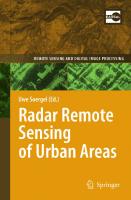
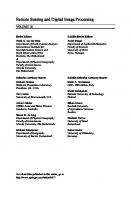
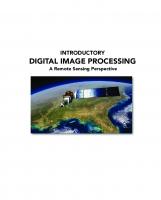

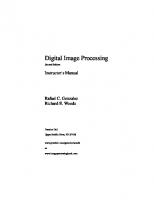

![Introductory digital image processing: A remote sensing perspective [4th ed.]
978-0134058160](https://ebin.pub/img/200x200/introductory-digital-image-processing-a-remote-sensing-perspective-4thnbsped-978-0134058160.jpg)

![Signal and Image Processing for Remote Sensing (Signal and Image Processing of Earth Observations) [3 ed.]
1032437413, 9781032437415](https://ebin.pub/img/200x200/signal-and-image-processing-for-remote-sensing-signal-and-image-processing-of-earth-observations-3nbsped-1032437413-9781032437415-d-4947246.jpg)